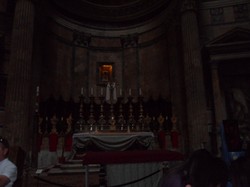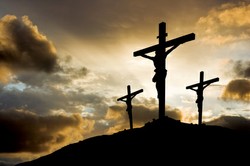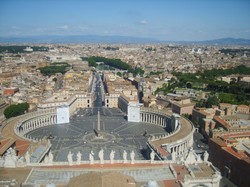Jesus left behind him a community with no clear Theology, which then his followers had to develop for themselves. This meant that from the earliest times Christians were debating and arguing with each other. Slowly over the years the structure of Christianity began to emerge, but from early on there were groups that separated from the rest, at first because their understanding of Christ differed from that of the dominant group, but later over other matters, such as salvation and the ministry. I want to clarify for readers the broad structure of these groups.

Understanding the divisions of Christianity
by frankbeswick
The huge variety of Christian groups sometimes baffles non-Christians, but they fall into broadly Catholic and Protestant, but these are wide categories.
The oldest surviving divisions
The Two Ancient Heresies
Religious groups have arisen and faded over the years, but there are certain ancient divisions in the church. The main division is between the Orthodox Christians and those who do not accept the teachings of the early councils. In this broad orthodox category I am including Catholic, Eastern Orthodox and Protestant, who both agree on the nature of Christ. Orthodox thought is that Christ was fully God and fully man, in two natures joined but not confused. At the council of Ephesus [431 AD] one group, the Nestorians, separated from the mainstream, as their leader, Nestorius, argued that in Christ the divine and human were merely in moral union, a Theology that made Jesus sound like one person inside another. The Nestorians still exist, and they are sometimes known as Jacobite Christians, though eighty percent united with the Catholic Church in the 1930s.
A much larger group are the Monophysite Christians. These separated after the council of Chalcedon [451 AD]. They include the Copts of Egypt, the Syrian Orthodox and the Armenians ansd one or two others. The schism was abstruse and unnecessary, and was more to do with personalities and ecclesiastical power seeking than genuine differences of faith. Whereas the orthodox Christians argued that Christ had two natures not confused but conjoined, the monophysites argued for one united nature. In practice it meant nothing, but religious ministers can too often be too proud to admit that they are wrong or to change cherished doctrinal formulae. Sadly, both sides claimed to be orthodox, and this has led to some confusion of terms. They group together into the Oriental Orthodox Church.
Copts
 | A Lonely Minority: The Modern Story of Egypt's Copts "A highly readable and urbanely authoritative account of the Coptic community of Egypt. Based on extensive research and travel, this sympathetic, but objective book portrays the... |
Nestorians
 | The Nestorians This book was originally published prior to 1923, and represents a reproduction of an important historical work, maintaining the same format as the original work. While some pub... |
The Great Schism
Yet another split due to ill-tempered clerics
1054 was a bad year for the church. Relationships between the church based at Rome and the one based at Constantinople were sour. Basically, the East was iriritated with the West because the Western church had been making some adjustments to the official creed of the church. Creeds had been decided by councils and can only be changed by councils, and one line was causing problems. It concerned the relationship between the three persons of the Trinity: Father, Son and Spirit. The creed of Chalcedon had settled on the formula that the Spirit proceeds from the Father. In the eighth century the Frankish church had started saying "proceeds from the Father and the Son". The East cried foul and said that changes should not be made without authorisation, but the Western church began to use this formula more and more, because of Frankish influence. The Eastern Church was correct, there was no right to change formulae without conciliar authority. However the new clause was known as filioque meaning [and from the son] so now we have the filioque problem.
The problem came when the new formula began to be used at Rome. This may have been because the Normans, who followed Frankish ways, had accepted it and, as they were protecting the pope, could more or less get away with doing what they liked at Rome; and being Normans, they did.
Still the issue nagged but did not flare up, until it became mixed up in ecclesiastical politics. The popes had been ordering Greek speaking communities in Italy to worship according to the Latin rather than the Greek rites, which annoyed the Greek church. So they decided that two could play hardball and ordered Latin communities in Greek territories to worship the Greek way. The Western church did not like receiving the treatment that it gave out to others and protested. So along came Cardinal Humbert, despatched to Constantinople with orders to sort out the problem. You might as well have hired an arsonist as head of the fire brigade.Humbert was a cantankerous, authoritarian type who managed to annoy the Eastern Christians.
Come the fatal day, he marched into the Cathedral of Hagia Sophia during mass and slapped a document on the altar excommunicating the Orthodox patriarch and his followers. The reasons were numerous, but they included filioque. Humbert's attitude was that the pope was the overall ruler of the church, and if he gives an order, you lot obey it. The East did not see it this way and would not obey a level of authority that they did not think appropriate in a church that should have authority more widely spread. The Church was now split into Catholic and Eastern Orthodox, which is a union of independent churches under the Patriarch of Constantinople,
Still relationships were not bad until the Norman crusaders ravaged Constantinople in 1205, in an orgy of bloodshed, rape and pillage. After that relationships deteriorated badly. Despite a brieft attempt at reunion in the fifteenth century the two churches have been split. What separates them now is not so much filioque, which was resolved in a discussion between pope and patriarch some years ago, but the issue of papal infallibility, which the orthodox do not accept. They dislike the authoritarian papacy that Rome developed. After serious improvements in East-West relationships made by Pope Benedict, there are hopes that Pope Francis might bring the split to an end.
Orthodoxy
 | The Orthodox Church: New Edition This updated edition describes the history of the Eastern Church over the last two thousand years. |
The Reformation
Ecclesiastical Chaos
The Reformation grew out of the rise of the middle classes in Northern Europe, who were literate enough to read their Bibles, and also out of the desire for reform in a corrupt church. There is a myth that the Catholic Church was totally corrupt. It was not, but there were entrenched problems that needed mending.
Certain groups arose out of the reformation. The Lutherans were the original Protestants. Whereas Catholics believed that you needed faith and good works to be saved and go to heaven, Lutherans believed in sola fide [by faith alone.] They believed in communion, but they did not believe that there was a special class of ordained priests. Instead they believed in the priesthood of all believers. They also believed in predestination, that God knows and chooses your eternal destiny from before you existed. While Catholics have seven sacraments, Lutherans accept only baptism and communion.
The Calvinists arose at Geneva, founded by John Calvin. In many ways they were like the Lutherans, but they believed in double predestination,that God not only chose who went to heaven, but also who went to hell, and that he did so arbitrarily, those going to heaven to receive his mercy, and those going to hell to deminstrate his wrath. Calvinists divided into presbyterians, who believed in government of the church by the presbytery, the assembly of ministers; and congregationalists, who believe in rule by the indepependent congregation. In recent years most of these have united into the united reformed church, but some congregationalists stayed out.
Baptists descended from a mediaveal group known as Waldensians. In many ways they are Protestant, but they never really liked justification by faith alone. Baptists tend to be fragmented and many of the wide range of churches that proliferate today are baptist, but they have grown to be indistinguishable from protestantism.
Lastly, the Church of England was an attempt by Elizabeth the First to avert civil unrest by forcing Catholics and Protestants to worship in one organisation. This is why it has Catholic and Protestant tendencies. Basically, it was an exclusively English affair, but then we got an empire and exported it.
Protestantism
 | The Reformation The National Book Critics Circle Award–winning history of the Reformation—from the New York Times bestselling author of Christianity and Silence At a time when men and women wer... |
Recent divisions
The most significant is the Old Catholics, who were expelled from the Catholic church in the nineteenth century because they would not accept papal infallibility. True Old Catholics belong to the Union of Utrecht, but there is a prpliferation of independent bishoprics that claim to be Old Catholic. There is an independent bishopric of Utrecht as well, which descends from a church that split from Rome after its rights were being infringed by the papacy. There is also a small Polish church in the USA which split from the Catholic church as it felt, probably rightly, that Irish Catholic clerics had their eye on its carefully husbanded resources. Many of these came back to Rome when the Polish John Paul became pope.
One group that gets itself into the headlines is the Lefebrites, who split from Rome because they did not like liturgical changes to the mass and because they detest any change or development in Theology. They are an ultra-conservative group who regard modern theology as an abomination and believe that there is currently no true pope. Negotiations on unity with the RC Church have effectively stalled as they insist that the Church accepts their theology, which the majority are not prepared to do.
There are other groups who separated form P{otestantism, but they are too numerous to count. With the exception of the Mormons, most are small. I have given a general outline of Christian groups, which I hope will be of assistance to those trying to navigate the minefield of understanding who is who in Christianity.
You might also like
Who was JesusTo understand Jesus you must realize that he was a mystery that theology trie...
Ministry in the church:women bishopsThe long awaited decision to have women bishops is major progress.



 TheThousand Year Gardenon 11/26/2025
TheThousand Year Gardenon 11/26/2025
 Women of the Gospelson 10/11/2025
Women of the Gospelson 10/11/2025
 Religious Gardenson 08/25/2025
Religious Gardenson 08/25/2025
 Doctor of the Church: John Henry Newmanon 08/03/2025
Doctor of the Church: John Henry Newmanon 08/03/2025



Comments
The Mormons do present as restorationists, but that description does not answer questions about ethics, it is entirely a different theological issue.
The introductory paragraph advises us that "The huge variety of Christian groups sometimes baffles non-Christians, but they fall into broadly Catholic and Protestant, but these are wide categories."
Latter-day Saints in Salt Lake City define themselves as restorationists. They give Restorationism as the fourth Christian category to Catholic, Orthodox and Protestant.
Might that restorationist self-identification be the way Latter-day Saintism is presented in the British Isles?
There is no unbroken lineage to the Cathars
The first sentence in the next-to-last paragraph in your next-to-last subheading, The Reformation, describes Baptists as "descended from a mediaveal group known as Waldensians."
Would there be any extant or extinct divisions descended from the Cathars, also known as Albigensians?
That clears it up. Thank you. :)
There is nothing official, churches arise and disappear, split and reunite. When they have been around long enough people come to accept them. I do think that Rome has never really accepted the Old Catholic movement, as they seem not to talk about them. In Britain we tend not to speak much of them as they are in communion with the Church of England, and the Old Catholics never open a church in a country in which there is a church with which they have communion.
The priest in the US that you mention opens up an issue. In the USA there is a proliferation of independent bishops, many of whom would like to be seen as Old Catholic, but are not parts of the Old Catholic Church. To become a bishop you must be ordained by another bishop, but many of them take their ordination from the successors of a rogue bishop who classed himself as an Old Catholic then drifted off on bis own course some decades ago. Many of these bishops have a few followers and say mass in garages or other improvised church.
The dividing line is always belief and authority. The Old Catholics were expelled over doctrine, their refusal to accept papal infallibility. The Lefebrites split over worship and authority. They objected to any change in the way that mass was said, whereas most of us welcomed the changes. Their rationale was that in 1555 the pope then had organised the mass with the instruction that these changes were in perpetuam, for ever. most of us think that this means "until the next pope changes it" but the Lefebrites said that this means that no change can ever happen. Rome was patient until they activated the trip wire by ordaining their own bishops, whereupon they were excommunicated. Their theology is very narrow and traditional, and they cannot accept that there is anything true other than a narrow theological tradition.
That was really informative. I've heard of many of these divisions in isolation, but never seen it all laid out in one place before.
Is there a standard for when an off-shoot church is seen as official? Or are they never viewed as such by those they left?
For example, there's a Catholic priest in America, who began by openly welcoming gay people into his congregation, and has progressed to actually conducting same sex marriages. This obviously hasn't gone down well with the Vatican, but the priest has simply side-stepped concerns by initiating his own brand of Catholicism. That's basically the same as before, with the addition of gay marriage being permissible.
I can see how that wouldn't necessarily count as a big division, because it's basically just one church. But where is that dividing line? Is it in numbers, longevity or merely mainstream acceptance?
I would never leave the Catholic Church, no matter what happened, but I want to draw closer to other churches, such as the Orthodox, Old Catholic and Anglican.
Hi Frank, Jesus must be very sad there are so many divisions. I'm staying Catholic because that was the religion founded by Him, with St. Peter as our first Pope.